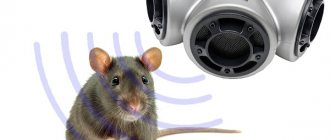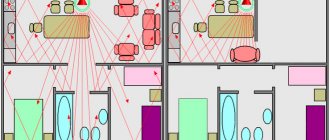Despite the popular belief that rodents can only squeak, screaming in a moment of pain, they are quite talkative creatures. Only they communicate mainly at frequencies inaccessible to the human ear.
This discovery is interesting not only for scientific purposes, but also has practical applications. Having understood what mice are afraid of and what signal they give, you can get rid of them by applying the knowledge gained without harming the animals.
Ultrasound in the life of rodents
Communication in this range is not a whim for animals, but a necessity. They can transmit alarm signals, exchange information, call their cubs, without fear of being heard by natural enemies.
Males, in the process of courting individuals of the opposite sex, perform real vocalizations in the ultrasonic range. Moreover, the older the animal, the larger set of sounds it uses. If a newly born mouse is capable of giving only a few signals, then an adult mouse reproduces more than two thousand.
When they chirp
Typically, crickets begin making sounds after sunset. It is in complete darkness that these musicians leave their hiding places. In nature, where crickets are not negatively affected by human activity, it is not a problem to hear these insects even during the day. Day and night they can also be heard during the mating season. Silencing this “musician” is quite simple; just get close to him at a certain distance. Sensing danger, the cricket will immediately hide in its hole.
Interesting fact! At night, crickets feel safe, which is why they make sounds mainly after sunset.
The structural features of the acoustic apparatus of grasshoppers do not allow them to make sounds at night. As soon as dew begins to fall, the wet organ cannot make sounds. Therefore, grasshoppers chirp exclusively during the day.
The Japanese simply adore these little “musicians”, so many breed them at home to enjoy this melody all the time.
Which frequency ultrasounds are best at repelling rats and mice?
Observations of animals in laboratory conditions showed interesting results:
- It has been noted that different species of rodents emit repellent ultrasounds at different frequencies. For example, when a rat detects danger, it emits a signal within the range of 32–33 kHz, and when experiencing painful sensations – 25–28 kHz. Mice prefer higher ranges, sometimes reaching 96 kHz. That is, it is impossible to scare off all rodents at once with the same ultrasound.
- Rodents learn quickly. If at first mice are afraid of a certain frequency, then, not detecting a risk to life, they gradually get used to it and stop reacting.
Repeller
An alternative to a rodent repeller - what else are rats afraid of?
The first way is cats. Natural enemies of rodents cope well with pests and at the same time give a lot of pleasant emotions to their owners. But will your “pedigreed” cat cope with hordes of rats, which are distinguished by their aggressive nature, and will the city pet be frightened by an armada of mice in a country house - the owner should think about this in advance. In addition, rodents are carriers of dangerous diseases; through a bite or wound they can easily infect a pet - and this is a clear disadvantage of this method
In village houses, cats are accustomed to rodents from a very young age and do their “job” very well. In the summer season, you can feed your neighbor’s cat at the dacha; he will quickly put things in order in the barn or garage.
In addition to cats, pests can be driven out by strong odors:
- technical fluids (gasoline, vinegar);
- black root, elderberry;
- essential oils.
The only downside is that after a while the smell disappears and the rats get used to it. In addition, all these “thermonuclear” odors are also unpleasant for the person himself.
How to scare away rodents using sound?
This is not to say that animals are only afraid of high frequencies. There are many other things that worry them.
Enemies of rodents try to behave very quietly before attacking. Therefore, the rustle, the sound that the wings of a bird of prey make, scares away mice no less effectively. It is pointless to use this to get rid of harmful animals, since in this case they tend to hide in minks.
Shouting, unexpectedly playing loud music, and unfamiliar sounds also scare away rats. True, this does not last long, since, having understood what is happening, they begin to treat them indifferently.
Attention! On an instinctive level, rats and mice tend to stay away from the place where the death cries of their relatives are heard.
To scare rodents away from home, it is most effective to use ultrasound, since it is not perceived by the human ear and does not cause additional inconvenience. Moreover, there is now a large selection of models on the market in different price categories.
What definitely won't repel rats?
Finally, it is almost certain that you will not be able to repel rats with the many cheap Chinese repellers that are actively sold on the Internet. In fact, these tools do nothing; often their task is simply to blink a light so that the user thinks that the device is working. They are bought in the hope of saving money and with the understanding that if the device does not help, then they will not mind the money spent. Actually, this is exactly what happens.
It is useful to pay attention to the operation of the repeller you are purchasing: if a device declared as ultrasonic clearly beeps, it means that it has nothing to do with ultrasound. Therefore, it is unlikely to drive rats out of the house.
The so-called magnetic resonance and electromagnetic devices, which supposedly create a field in the apartment’s electrical network that repels insects and rodents, are also useless. There is no theoretical explanation for this effect, but in practice people find that rats and mice do not pay attention to such devices at all.
On a note
Another sure sign of an ineffective repeller is a statement from the manufacturer or seller that the device is supposedly universal and repels all parasites and pests in the house in general - not only rats, but also bedbugs, cockroaches, woodlice, flies...
Various folk repellents almost always turn out to be useless. For example:
- Elder;
- Broken glass scattered near rat passages;
- Black beans;
- Red pepper, also scattered near rat shelters;
- Ash;
- Singed fur;
- Burnt rubber...
At best, these drugs can cause some alertness in rats, but not for long. The animals quickly get used to it and do not leave the house.
If you have personal experience in repelling rodents from your home (by any means), be sure to share the information by leaving a review at the bottom of this page.
Interesting video: ultrasound on Android
Can you use a computer or phone to repel rodents?
On the Internet, when asked “sounds that repel mice,” the search engine returns many sites offering to download audio files. And nowhere is it mentioned that the speakers of modern phones and computer speakers are not designed to reproduce ultrasound.
Attention! Speakers were made for humans, and they cannot reproduce high frequencies correctly.
It’s also good if, when downloading, a person receives a dummy or an unpleasant sound. There is a high risk of infecting your phone or laptop with a virus.
How do professionals get rid of mice?
How do exterminators get rid of mice?
- Eliminate entry points. Mice don't need very large entry points to get into your home. ...
- Set up mousetraps. ...
- Set up baits. ...
- Fumigate for mice. ...
- Make sure you have somewhere to stay. ...
- Arrange to have your gas turned off. ...
- Leave all your interior doors open. ...
- Securely seal all products and supplies.
18 Feb 2022
Types of rat and mouse repellers
The variety of models and wide price range for mouse and rat repellers causes confusion for many people. The choice falls on the model that the sales consultant recommends. At the same time, all the nuances of operation and types of rodents are not always taken into account. Hence the ineffectiveness of use. Money wasted.
To choose the most suitable device, you need to know that they are divided by type of impact:
- to ultrasonic;
- to electromagnetic;
- to combined ones.
Depending on the power source, they can be connected to the mains, battery-powered, solar-powered, or combined.
Ultrasonic devices
Such models are more suitable for open spaces and rooms without partitions, since any obstacle dampens sound waves, and the mouse and rat repeller will work idle.
Ultrasonic device
Equipment configured to emit ultrasound at 20–70 kHz will make the animals nervous and quickly look for another shelter, but humans cannot hear the vibrations emitted by the device.
Adaptation of rodents to an irritating factor can be avoided if the generator allows you to change the frequency of the sound.
The device that drives away rats and mice is placed in the center of the room on a raised platform and left to work for a day. After a 12-hour break they turn it on again. With this repeller mode, the rodents disappear in 2–3 weeks.
Electromagnetic devices
These devices induce magnetic pulses that change the natural electromagnetic background in a limited area. Animals react very sensitively to such things and begin to panic. In the first days of operation of the repeller, rodents become more active, but after a week they begin to leave in search of a more favorable place to live.
The repeller can be attached to the wall. Any metal object nearby will contribute to the propagation of electromagnetic waves.
Combination devices
Combined rat and mouse repellers combine the advantages of ultrasonic and electromagnetic devices. By creating two negative factors for animals at once, they are guaranteed to force rodents to leave the premises. The only disadvantage of these devices is their higher price.
Why do crickets make sounds?
The first and main reason for the appearance of these pleasant sounds is the peculiarities of the reproduction process. A sexually mature male, making sounds, tries to attract a female for fertilization. The male is able to make such sounds from dawn to dusk, until the female hears him. His efforts may be rewarded if the sounds are loud and melodious enough.
The second reason is related to the peculiarities of his life. Crickets prefer to lead an isolated lifestyle, occupying a certain territory, which they protect and designate with the help of sounds. Apart from females, males do not allow anyone into their territory, walking around their territory several times a day, checking if anyone outside has appeared.
Interesting to know! The sounds made by the cricket are aimed at scaring away uninvited guests.
In any case, regardless of the reason for the appearance of such sounds, a person receives pleasure from them. Many people compare the sounds made by crickets to the trill of birds, so they often breed these insects in their apartment. As many have pointed out, there are no difficulties in this regard. In addition, crickets in captivity “sing” not only at night, but also during the day.
The sound of a cricket. How a cricket sings
What to look for when choosing?
To get rid of mice and rats forever, when choosing a repeller, you need to take into account all the important factors that affect the effectiveness of its operation. Before buying, you need to answer yourself a few questions:
- Where will the equipment be used? An electromagnetic device is more suitable for home use. Ultrasonic can be used in one room or cellar. But it works well in the area if trees and bushes do not interfere with the passage of the sound wave. Universal repellers can be used both indoors and outdoors. Particular attention should be paid to the range of action. If the room is larger than the device declared in the passport, you will have to buy several pieces.
- Will there be people in the house while the repeller is operating? At a sound pressure of 110–130 dB, the animals are more likely to leave the inhabited territory, but humans will also feel uncomfortable.
- Are there outlets everywhere to connect to the electrical grid? If you have to pull an extension cord, then perhaps devices with an autonomous type of power supply will be more convenient.
Insect protection net - Anti Mosquito (iPhone and iPad)
This application will help you get rid of annoying mosquitoes. Your iPhone will emit ultrasound that repels mosquitoes and is audible only to them.
The application is compatible with all second-generation iPhones and iPod Touches, as well as iPads.
QR Code
Anti Mosquito - Sonic Repeller
Developer: Pico Brothers
Price: Free+
Compatibility: Requires iOS 7.0 or later. Compatible with iPhone, iPad and iPod touch.
Why do ultrasonic devices sometimes not work?
Unfortunately, it is impossible to check the parameters of the repeller declared by the manufacturer without special instruments. Therefore, a lot of fakes have appeared on the market. The low price compared to similar models from other companies should cause caution.
In addition, the incorrectly defined coverage area of the equipment plays a role. It should be slightly larger than the area of the house.
Mouse
An incorrectly chosen location for the repeller can make the purchase pointless. Any obstacle will interfere with the passage of sound waves. Sometimes the way out of the situation is to purchase several, less powerful devices.
Is ultrasound safe for humans and pets?
Although the human ear cannot detect high-frequency sounds, powerful devices can lead to headaches and poor health. Therefore, it is not recommended to install them in rooms where people are constantly present.
Hamsters and guinea pigs hear ultrasound very well, so they need to be relocated while the equipment is operating. Cats and dogs are also susceptible to the negative influences emanating from the repeller. Observing the behavior of animals will tell you whether it is worth turning on the device in their presence.
Ultrasound against mosquitoes
In their life activities, blood-sucking creatures are guided by a keen sense of smell and ultrasound. Insects detect infrared rays, the smell of carbon dioxide, lactic acid, and sweat. They are able to determine the location of a potential victim from a distance of several tens of meters.
The sound from mosquitoes, according to manufacturers, is of a certain frequency. The human ear cannot detect it, but insects hear well. What frequency it should be, studies were carried out, as a result of which a value of 4 kHz - 6 kHz was revealed.
On a note!
Manufacturers claim that the mosquito-repellent sound imitates the flight of a dragonfly. However, the predator, by flapping its wings, creates ultrasound at a frequency of 20 kHz, which contradicts the information indicated on the device. If mosquitoes heard the approach of a dragonfly so clearly, they would not become victims of a predator and would have time to move to a safe distance.











